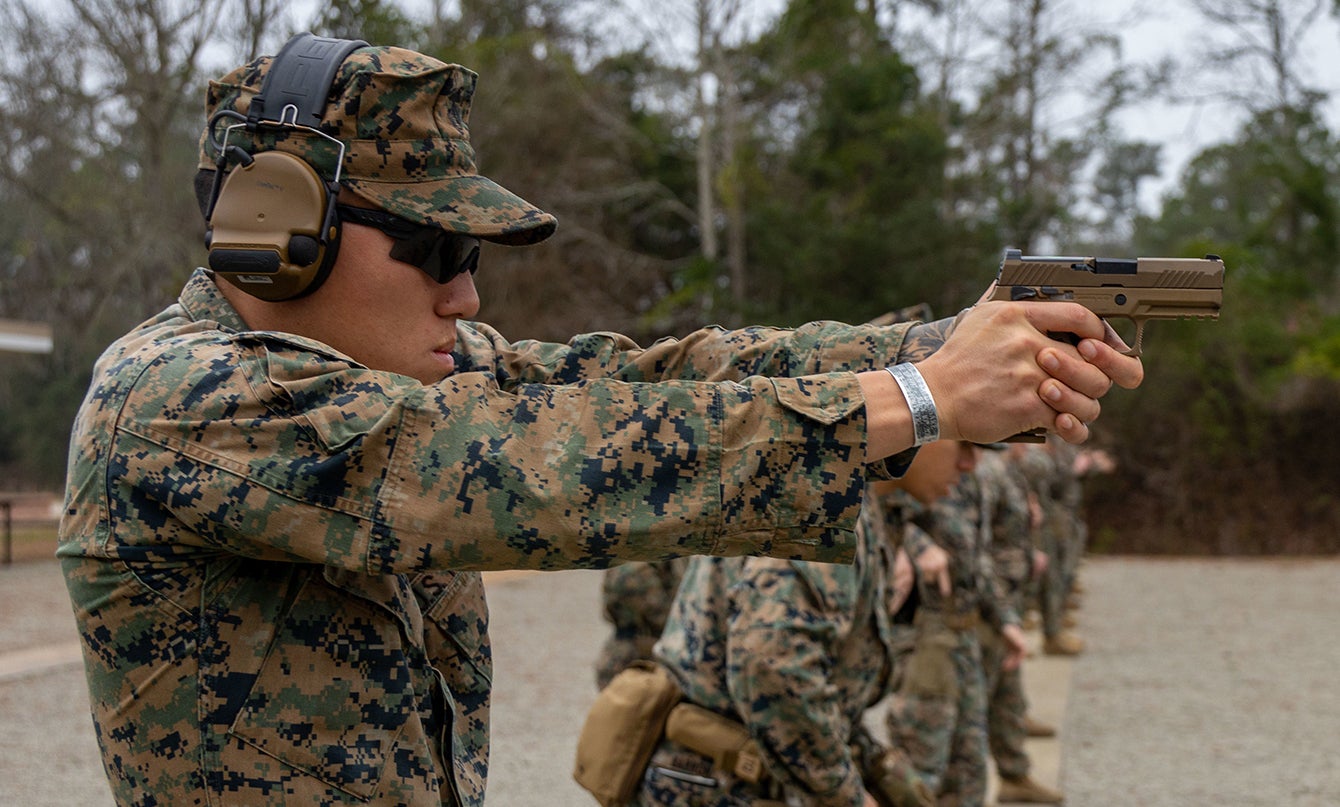
The Marine Corps may soon change how it grades the shooting in its Combat Pistol Program, giving more points to lethal shots and devaluing non-lethal shots, Corps officials said.
“We’re not asking everyone to be able to shoot a pistol at MARSOC [U.S. Marine Corps Special Operations Command]-level quality, because if we did, then potentially no one would pass, and it then would create an undue burden on commanders,” said Col. Gregory L. Jones, commanding officer of the Weapons Training Battalion. “But we also know that the current qualification isn’t really good enough in light of all of our other insights and learning and changes.”
That goal is to make the Marine Corps’ pistol training more like the Annual Rifle Qualification, in which Marines generally only get points for hitting targets with shots that equate to hits on the heart, lungs, and head, Jones told Task & Purpose.
The last time the Marine Corps updated pistol training was in 2014, when it changed the targets that Marines shoot at from bullseyes to human silhouettes, Jones said.
“Analyzing scores and data, we learned that you can qualify with the pistol without placing one lethal shot, and it only takes one lethal shot to qualify expert,” said Chief Warrant Officer 4 Josh Grayek, the gunner for the Corps’ Weapons Training Battalion. “We want to change the dynamic to where you now have to be required to make more lethal shots in order to qualify.”
Subscribe to Task & Purpose today. Get the latest military news and culture in your inbox daily.
Marine Corps officials are still working out the scoring system to determine whether Marines would get any points for non-lethal pistol shots, Grayek said.
“That could, potentially, make pistol training – or the qualification – significantly more challenging,”,” Grayek said. “So, we’re analyzing average shot locations and placements and an alternate solution may be a scaled scoring system where, as an example, a lethal shot would be 10 points and shoulder shot would only be like one or two points.”
The results of the Combat Pistol Program experiment will be briefed to Corps leaders at the end of September, Grayek said. If changes to pistol training are approved, they could be implemented starting in late Fiscal Year 2025 or Fiscal Year 2026.
Jones and Grayek talked to reporters on March 7 ahead of the release of MARADMIN 123/24 on Monday, which outlined the latest changes to the Marine Corps’ marksmanship training, which covers how Marines qualify and train with their rifles.
Changes to the rifle shooting include having more Marines scored by the Rifle Marksmanship Assessment, or RMA, instead of a second set of standards known as Tables 3 through 6
Those tables are used to score short bay training with rifles – which includes close quarters battle shooting drills – and unknown distance marksmanship training, Corps officials said.
Marines will continue to shoot rifles at the distances laid out in Tables 3 through 6, which range from 15 to about 300 meters, Grayek said. The RMA is meant to look at more than just how accurately they shoot.
“In the competitive shooting world, they have what they call ‘hit factor scoring,’” Grayek said. “It takes the points that would shoot, the actual physical bullet location target, and it gives them a point; but then it also divides that by how long you took to shoot.”
That means that Marines’ performances on shooting drills will not just be measured by where they hit the targets, but also how quickly they get off their first shot, how fast they can reload, and how quickly they can transition from one target to another while making lethal hits, Grayek said.
“With that, we can now take a look from macro- to micro-level to diagnose the individual, the squad, the platoon, all the way up to the Marine Corps as a whole, and we can figure out where we need to make improvements in subsequent years and shooting packages,” Grayek said.
The Marine Corps has already begun the process of introducing the RMA at the School of Infantry and at The Basic School, while Marines in the fleet could start being scored by the assessment next year, Corps officials said.
In another change, Marine recruits and student officers will be able to use their rifles’ magazines as a support for their weapons when they fire in the prone position, MARADMIN 123/24 says. Previously, Marines had only been able to use their magazines for support while zeroing their weapons.
Marines are already allowed to use their magazines as a bipod for prone shooting when they take the Annual Rifle Qualification, said Jones, who added Marines now have Magpul magazines, which are much sturdier for support than the metal magazines long issued with M-16-style rifles. .
“That old magazine didn’t properly fit into the magwell,” Jones said. “It often would cause double feeds. But now that we have better technology, there’s no reason not to be able to use that in prone supported [marksmanship training]. So that starts to be one of the first, we believe, easiest ways to cross-pollinate best practices from other advances in marksmanship over entry-level training.”
The Marine Corps has made several changes following a 2018 internal analysis, which determined that Marines did not do a good job of shooting while moving, shooting at moving targets, and shooting at unknown distances; and that the Corps was not collecting enough data to analyze the effectiveness of its marksmanship training, Jones said.
“We’ve seen massive improvements in training,” Jones said. “Folks shouldn’t be worried about failing. They should be focused on – and proud of the service – for being really, really serious about finding better pathways to train and increase their lethality, so when they do go downrange, they are better to defend themselves and their peers.”
